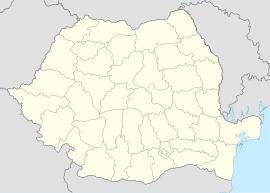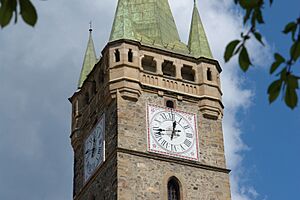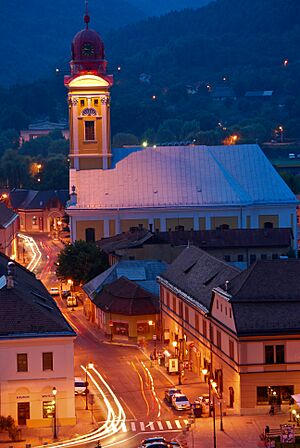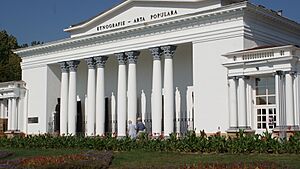Baia Mare facts for kids
Quick facts for kids
Baia Mare
|
||
|---|---|---|
 |
||
|
||
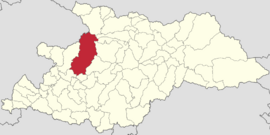
Location in Maramureș County
|
||
| Country | ||
| County | Maramureș | |
| Area | 233.47 km2 (90.14 sq mi) | |
| Elevation | 228 m (748 ft) | |
| Population
(2011)
|
Lua error in Module:Wd at line 1,575: attempt to index field 'wikibase' (a nil value). | |
| Time zone | EET/EEST (UTC+2/+3) | |
| Postal code |
430311
|
|
| Area code | 0262 | |
Baia Mare is a city in northwestern Romania. It is located along the Săsar River and is the capital of Maramureș County. The city is part of the Maramureș region, which is a subregion of Transylvania.
Baia Mare is about 600 kilometers (370 miles) from Bucharest, Romania's capital. It is also close to the borders with Hungary (70 km or 43 miles away) and Ukraine (50 km or 31 miles away).
The city is found south of the Igniș Mountains and Gutâi Mountains. In 2021, Baia Mare had about 108,759 people living there. Its larger metropolitan area is home to around 200,000 residents. Baia Mare also manages four nearby villages: Blidari, Firiza, Valea Borcutului, and Valea Neagră.
Baia Mare was chosen as the Romanian Youth Capital from May 2, 2018, to May 1, 2019. It is known as the greenest city in Romania, with 133 square meters (about 1,430 square feet) of green space for every person.
Contents
History of Baia Mare
Early Times
The area around Baia Mare has been a good place for people to live since the Stone Age. This is because of its location on the Săsar River and its warm, Mediterranean-like climate.
During the Bronze Age, Thracian tribes lived here. Later, the region became part of the Dacian Kingdom under King Burebista. Mining for gold and silver began around this time, as the area is rich in these metals.
Middle Ages in Baia Mare
Baia Mare was first mentioned in official papers in 1328. It was called Rivulus Dominarum, which means "Ladies' River." In 1347, King Louis I of Hungary recognized it as an important medieval town. It had a busy mining industry. The town was run like the "free towns" of that time.
In 1411, King Sigismund gave the town and its mines to the Hunyadi family. This was to thank Janos Hunyadi for helping stop the Turkish invasion.
The town grew and became very successful. The St. Stephen Cathedral was built during this time. Today, its tower, known as Stephen's Tower, is a famous landmark. The first school in Baia Mare, called Schola Rivulina, opened in 1547. It was started by the Reformed Church after the Protestant Reformation.
Modern History of Baia Mare
In 1703, a local hero named Pintea Viteazul and his group briefly freed the town. It had been under the rule of the Holy Roman Empire. Pintea is now seen as a symbol of freedom in the town's history. Some of his belongings, like his chain mail shirt, are kept in a nearby church.
In 1748, the city's mining industry grew even more. The Austrian authorities set up a "Superior Mining" headquarters here.
In the late 1800s, many young Hungarian artists, including Simon Hollósy, went to study art in Munich. Hungary did not have an art academy then. Simon Hollósy taught new European art techniques in his studio.
Some of these artists decided to live and work together in Baia Mare, which was then called Nagybánya. They convinced Hollósy to join them. They started the Nagybánya artists' colony. They focused on painting nature and doing plein air painting (painting outdoors). This artists' colony became famous for influencing Hungarian and Romanian art in the 20th century.
After World War I, the Austro-Hungarian Empire ended. In 1920, Baia Mare officially became part of the Kingdom of Romania. It became part of Hungary again in 1940 during World War II. After the war, the city was returned to Romania.
In the years after World War II, Baia Mare grew a lot. Its population increased, and new areas were built. In the late 1970s and early 1980s, a new town centre was developed with modern architecture buildings.
Environmental Event
On January 30, 2000, Baia Mare was the site of a major environmental event. A dam at a gold processing plant broke. This caused a large amount of water mixed with cyanide and heavy metals to spill. The spill flowed into the River Tisza and then into the Danube. It affected several countries, including Romania, Hungary, Ukraine, Serbia, and Bulgaria.
This event caused a lot of harm to nature. More than 1,400 tons of fish died, along with many eagles, storks, and otters. Scientists worried that some fish species might disappear forever. Because of this accident, Hungary banned the use of cyanide in gold processing. It also asked other European countries to do the same.
Baia Mare's Coat of Arms
The coat of arms for Baia Mare was given to the city by the Government around the late 1990s or early 2000s.
The shield on the coat of arms is divided into two parts. On the right side, there is a miner in a mine. This represents the city's main economic activity, which is mining. On the left side, there is a church tower. This tower stands for the city's cultural and religious history.
The shield is topped with a mural crown that has seven towers. A mural crown is a crown shaped like a city wall. The seven towers show that Baia Mare is a very important city and the capital of a county.
Geography of Baia Mare
The city is located near the Gutâi and Igniș Mountains mountains. Some peaks in these mountains reach up to 1,400 meters (about 4,600 feet) high. The area is known for its beautiful landscapes. It is easy to reach the mountains from the city. Some famous peaks include Igniș (1,307 m), Mogoșa (1,246 m), and Creasta Cocoșului (1,450 m).
Baia Mare is in a valley, surrounded by hills and mountains. This makes the city's climate milder than the areas around it. For example, chestnut trees, which usually need a warmer, Mediterranean climate, grow here. This is the northernmost place where chestnut trees can be found. However, temperatures can change suddenly, and in winter, they can sometimes drop below -20 degrees Celsius (-4 degrees Fahrenheit).
Summers in Baia Mare are mild and cooler than in other parts of Romania. The area gets a lot of rain, almost 1,000 mm (about 39 inches) per year. This is because the mountains to the north and east trap the air masses.
Baia Mare is the most populated city in northern Romania. It has a high level of culture and education. You can find theaters, schools, museums, and art galleries here.
Near the city, there are important nature reserves. These include Creasta Cocoșului, Cheile Tătărului, and Lacul Albastru. Because of its special location in the Eastern Carpathian Mountains, Baia Mare is considered one of the most beautiful cities in Romania.
Population of Baia Mare
| Historical population | ||
|---|---|---|
| Year | Pop. | ±% |
| 1912 | 12,877 | — |
| 1930 | 13,904 | +8.0% |
| 1948 | 20,959 | +50.7% |
| 1956 | 35,920 | +71.4% |
| 1966 | 62,658 | +74.4% |
| 1977 | 100,985 | +61.2% |
| 1992 | 149,205 | +47.7% |
| 2002 | 137,976 | −7.5% |
| 2011 | 123,738 | −10.3% |
| 2021 | 108,759 | −12.1% |
| Source: Census data | ||
At the 2021 census, Baia Mare had a population of 108,759 people. This was a decrease from the 123,738 people recorded in the 2011 census.
Most of the people living in Baia Mare are Romanian (about 84%). There are also many Hungarians (about 12%) and Roma (about 3%). Smaller groups include Germans and Ukrainians.
The Baia Mare metropolitan area is much larger, with about 215,932 people. It includes Baia Mare city, five towns, and 13 smaller communities.
Past Population Details
In 1912, out of 12,877 people, most were Hungarians (including Jews). There were also Romanians and Germans.
In 1920, out of 12,780 people, there were Romanians, Hungarians, Jews, and Germans. Many people who spoke Hungarian were not necessarily ethnic Hungarians.
Before World War II, Baia Mare had over 1,000 Jews. In 1944, most Jews were sent to concentration camps. Most of the few who survived later moved away. In 2011, 32 Jews lived in the city. Baia Mare had a Jewish settlement called a shtetl. The local synagogue was built in 1885.
Economy of Baia Mare

For a long time, Baia Mare's economy depended on mining in the surrounding areas. However, after the 1989 Revolution, mining greatly decreased. Now, other activities have helped the city's economy grow.
Baia Mare has become one of the most developed cities in its region. Many supermarkets have been built, along with one of the largest shopping malls in over 100 kilometers (62 miles). Italsofa, a very large sofa factory in Eastern Europe, is located near the city's highway.
Aramis Invest is Romania's biggest furniture maker and exporter. In 2014, it was the largest supplier to the Swedish company IKEA in Romania.
The city also has train services for both passengers and goods. These are provided by CFR, Romania's national railway company.
Culture in Baia Mare
Baia Mare has a rich cultural life. It has one main library with several branches, six museums, a planetarium and observatory, two theaters, and two cultural centers. There is also an art school and a public university.
- The Cathedral of the Holy Trinity is the second largest cathedral in Romania.
- The Planetarium and Astronomical Observatory in Baia Mare has modern equipment. It uses a Zeiss Skymaster ZKP4 star projector to show clear views of the stars.
- The Arts Center Baia Mare includes an Art Museum and an Ethnography and Folk Art Museum.
- The Museum of Mineralogy Baia Mare has a special collection of minerals from the region. Many of these exhibits are unique and very valuable.
- The Nagybánya artists' colony started as a summer place for artists, especially painters from Simon Hollósy's school in Munich.
- The Puppet Theater Baia Mare was founded in 1956.
- The County Museum of History and Archeology Baia Mare tells the story of the region.
- The Municipal Theater Baia Mare started with a semi-professional group in 1796. A State Theater was officially established in 1952.
- The "Petre Dulfu" County Library is a public library with seven branches. It is named after the scholar Petre Dulfu.
- Stephen's Tower is over 40 meters (130 feet) tall. It was built in a neo-Gothic style and is a symbol of the city.
Famous People from Baia Mare
Sportsmen
|
|
Singers and Composers
- Dora Cojocaru - composer and music expert
- Gheorghe Costin - conductor and composer
- Adrian Sina- singer and composer
- Paula Seling - singer and composer
- AMI (Romanian singer) - singer and composer
Painters
- Adrian Ghenie
- István Réti
Other Notable People
- Csaba Ferenc Asztalos - politician
- Mihai Morar - entertainment journalist
- Lucian Mureșan - Cardinal, a high-ranking church leader
- László Németh - writer
Education in Baia Mare
Baia Mare has many schools for young people. There are 23 schools, 34 kindergartens, and 18 high schools. For higher education, the city has several universities and colleges:
- Northern University
- Bogdan Vodă University from Baia Mare
- Vatra University of Arts from Baia Mare
- Vasile Goldiș Western University Baia Mare
- Iuliu Hațieganu University of Medicine and Pharmacy Baia Mare extension
- Carol Davila Post-secondary School of Health
Some of the national high schools in Baia Mare include:
- Gheorghe Șincai National College
- Emil Racoviță Theoretical Highschool
- Vasile Lucaciu National College
- Mihai Eminescu National College
- Arts College
- "Nicolae Titulescu" Economics College
- Highschool of Sports
- "George Barițiu" Technical College
- "Anghel Saligny" Technical College
- "C.D. Nenițescu" Technical College
- "Németh László" Theoretical Highschool
Twin Towns and Sister Cities
Baia Mare is twinned with several cities around the world. This means they have friendly relationships and often share cultural exchanges.
 Bielsko-Biała, Poland (2001)
Bielsko-Biała, Poland (2001) Combs-la-Ville, France (2009)
Combs-la-Ville, France (2009) Hódmezővásárhely, Hungary (2001)
Hódmezővásárhely, Hungary (2001) Hollywood, United States (2001)
Hollywood, United States (2001) Kitwe, Zambia (1972)
Kitwe, Zambia (1972) Nyíregyháza, Hungary (2001)
Nyíregyháza, Hungary (2001) Serino, Italy (2003)
Serino, Italy (2003) Szolnok, Hungary (1990)
Szolnok, Hungary (1990) Wels, Austria (2000)
Wels, Austria (2000)
Structures
- The Chimney of Phoenix Copper Smelter is 351.5 meters (1,153 feet) high. It is the tallest structure in Romania.
Images for kids
See also
 In Spanish: Baia Mare para niños
In Spanish: Baia Mare para niños



